I went to the desert of New Mexico with one mission: to run a marathon in memory of my grandfather. And, though he’s no longer here to comment on my blog as “Grampa Ben,” I think he’d be proud of me for having the determination to overcome many challenges to reach that finish line.
I’ve had a few tears in my eyes at race finish lines, but this was the first in 17 marathons that I found myself sobbing as I ran through the finish chute. Two soldiers even asked if I was okay. I said “Yes, thank you,” because I couldn’t put into words why I was crying. It was a mix of sadness and happiness, of broken and healing hearts, of fear and hope. Most of all, it was because Grandpa’s grin had just flashed through my mind.
To tell the story of my Bataan Memorial Death March Marathon experience, I should go back 2 years, 3 months and 2 weeks – or 119 weeks. That’s the last time I ran a marathon. The IT band in my leg had started acting up, and it worsened halfway through that December 2013 marathon where my friends were tracking me and saying, “She’s on pace to qualify for Boston!” I tried doctors and therapy and cross training, but my leg simply was not happy. I took it into my head to just get used to NOT running. After all the childhood excuse notes out of physical education, and after all the recent running, I decided that was my new reality. And I stuck to it for quite awhile.
But running still called me. I wasn’t done with it, and it wasn’t done with me. Nearly a year later, in the fall of 2014, I signed up for a half-marathon the following August. And then in spring of 2015, I threw my name in the lottery for the 40th annual Marine Corps Marathon that would be held the next October. My perfect race lottery track record held up yet again, and my name was selected. Around the same time, I crossed a goal off my list by trying a Body Pump class at my gym. I’d never done so many squats and lunges in my life, and I was sore for several days. But my IT band didn’t hurt at all. I kept going back, and my IT band remained silent. Perhaps this was a partial cure. In the meantime, I bought a road bike and shifted my focus to cycling, so that helped me regain some fitness without attempting to return too quickly to running. (“Shifted” wasn’t an intentional pun — that was inherited from Grandpa.)
I didn’t leave myself a lot of time to train for that August half-marathon. I was more worried about hurting my leg than anything else, so I kept the mileage low. The race was almost 25 minutes slower than my personal record, but I finished with an intact IT band and decided I could actually run the Marine Corps Marathon. And then I broke my thumb three days later. I sold my race bib (legally) and canceled the expensive hotel I had booked, putting the money toward my insurance deductible.
I had hand surgery around the same time my grandfather couldn’t get out of bed and said he needed to go to the hospital. This alarmed the entire family, because he never asked to go to the hospital. The plan had long been that I would be the first to get on a plane, because I was the closest family member by several flying hours and the only one who could get there on a non-stop flight. Now, I couldn’t go; by the time I could travel, it was too late. Grandpa never returned home, and we lost him on October 14, 2015. His determination never wavered, even at the very end.
Somewhere in the midst of everything, I heard about the Bataan Memorial Death March Marathon. I’ve been fascinated by World War II since childhood, but I had never heard of the Bataan peninsula in the Philippines. American and Filipino soldiers tried to defend it, but it fell to Japan in April 1942. Thousands of soldiers were taken prisoner and forced to march for seven days without food or water. Most died. Those who survived were then subjected to brutal prison camps, where more died. Filipino residents tried to help the American soldiers, and were killed for their efforts.
For the past 25 years, a marathon has been held in the desert of New Mexico to honor those who experienced the Bataan march. Bataan survivors, many of whom live in New Mexico, attend the marathon every year, shaking the hand of any and every marathoner. And every year, fewer survivors remain.
I’ve never been to New Mexico, and I want to see every U.S. state. And, hey, it would get me another state if I ever decide I can attempt a marathon in each one. But the main reason this race would not leave my head was the meaning. Grandpa wasn’t at Bataan, but he served in the Army in the South Pacific. He could very easily have been sent to Bataan. I couldn’t stop thinking about the marathon.
New Year’s Day came, and friends told me: “Here’s to a better year.” Well, that was not to be. On January 12, my world shattered from more family medical crises. The second surgery I needed on my thumb paled in comparison. The idea of going to New Mexico to run a marathon seemed ludicrous and selfish.
But once I started looking through the prisms of my shattered world, I knew I had to keep living, now more than ever. I could only be strong for my family if my own mind and soul and body were strong. I needed to make decisions that would make me happy and that I wouldn’t regret later. I still wanted to run Bataan in Grandpa’s honor, and I feared that I might put it off until there were no survivors left. I registered for the marathon just three weeks before it was to be held.
After changing my itinerary three times due to family matters, I found myself sitting on a plane beside the friend who had bought my Marine Corps Marathon bib. We landed in El Paso, Texas (a new airport for me), ate carbs, then headed to White Sands Missile Range in New Mexico. The drive went past “tank crossing” signs and others that warned people to stay in their cars. It’s very much an active missile range, and the military doesn’t mess around.

Upon reaching a gate, everyone had to wait for clearance through the National Criminal Information Center database. Old speeding tickets didn’t count, so they let me inside to collect my bib, shirt and medal/dog tag — this was given out before the race, kind of like one final reminder that I was to finish what I started.
I was back there at the starting line before dawn Sunday morning, surrounded by marchers and runners, and outnumbered by those who wore camouflage.
It was freezing cold, especially since I was wearing a thin tank top and shorts. I received many comments about how cold I must be, though later I would hear people saying, “I wish I had worn a tank top” as we passed. I hadn’t worn my Marathon Maniacs tank top in almost three years, so it was fun to feel like I was part of a running group again.
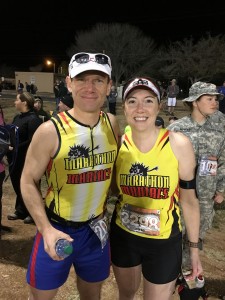
The opening ceremonies included a number of military rituals, including the national anthem, a fly-over by a medical helicopter, a roll call of Bataan survivors present, and a roll call of those who had died since the previous year’s marathon. That list numbered 21; I can’t imagine what it will be like when only one name remains, and then none.
At 7:30 a.m., we were on our way. The race has a marathon and a 14-mile route, and the majority do the marathon. There are civilian and military categories, and “light” and “heavy” options: You can choose to carry a 35-pound pack. Many service members wear their full military fatigues, including the boots that are quite sturdy but not exactly ideal for marathon running. Many of them walk the entire route, some carrying flags and some wearing prosthetic legs. I passed one young man with two prosthetic legs and heard him saying “I got blown up,” and knew he was telling the story of how he lost his legs.
The first few miles were on pavement, and I did my best to rein in my pace, since I had a long way to go and was starting at 4,000 feet altitude. I chatted for two miles with a Maniac named Maria who helped me set my pace. She was born in the Philippines said Bataan is a big deal there — she learned about it as a child. When I left her, I picked up the pace, but managed not to be too reckless. I have my fueling pretty well dialed in by now, and I just eat five gels during the course of a marathon when I’m supposed to, whether they’re appealing or not. I carried my trusty old handheld bottle and told myself to stop and refill it at least twice so I’d keep drinking and hopefully stave off the effects of altitude.
The climbing began around mile 7 and did not relent until mile 13.5, at 5,400 feet elevation. I had noted this ahead of time so I knew what mile point I was looking toward. What I hadn’t fully expected was the sand. I’ve run plenty of trails, but not loose sand. Sand combined with uphill (and my lack of training) to reduce me to many, many walking breaks. I chatted with various Maniacs, sometimes leaving them and sometimes being left by them. I leap frogged with some people through much of the race. The views were lovely and peaceful, the weather was perfect with warm sun but a breeze that cooled me. The aid stations had water, cold (bonus!) Gatorade and orange slices that hit the spot for me.
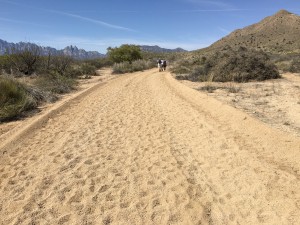
Mile 13.5 brought the reprieve from all that climbing, and I finally found myself running downhill on what was thankfully packed dirt. I did lose a minute to fish a rock out of my shoe, but that was the only time I thought I should have worn gaiters.
Somewhere around mile 19, we returned to a paved road we had run up. Walkers were still heading up, and nearly all of them were in full military gear. I had just reached the “furthest I’ve run in more than 2 years” point, I was going downhill, and I had amazing people to smile at. As a bonus, many of them returned my huge grin with compliments and smiles. Fortunately, I looked at my watch and saw the 8:30 pace so I slowed down – I still had seven miles to run, and I was really not in shape to be running that pace at that point.
We returned to packed sand, and I said hello to a gal who was wearing military fatigues and had a Maniac sign pinned on her back. Her name was Laura, and we ran together from about mile 20 to 24. She was such a sweetheart, and I was fortunate to have her company through the notorious “sand pit,” which wound up being about 1.5 miles long.
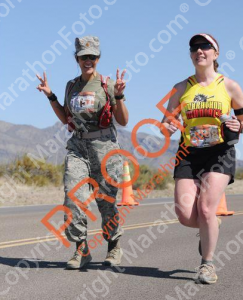
I felt a little guilty, but I left Laura at mile 24 and began to run. I knew I could probably jog most of the last two miles, and I wanted to get this done. I also wanted to try to run those miles to finish strong for Grandpa. And so I did, sometimes very slowly because my legs really wanted to stop.
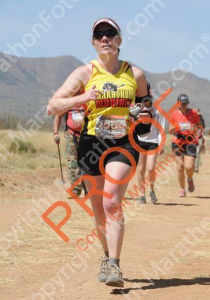
People were cheering, soldiers and civilians alike. I rounded a corner and saw the finish line, and Grandpa’s smile flashed into my head. I started to cry. I picked up the pace and didn’t want to stop running because I was afraid I’d start bawling, but someone had to scan my bib so I came to an abrupt stop. I was crying but trying to hide it behind my sunglasses. Then I realized the survivors were just beyond the finishing chute. Those elderly men had been there in the morning when we started, and they were still here. I gently grasped their hands, saying “thank you” through tears to each one. What they didn’t know was that I was also thinking, “thank you for being there instead of my grandfather.”
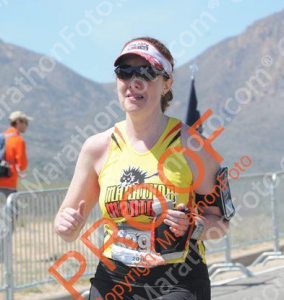
Post-race delirium always hits me, but this time I think the emotions made it worse. I usually text a few people from finish lines, but I was too drained to think about it, aside from Eliot, whom I’d texted from mile 21 and 24, trying to coordinate post-marathon shenanigans. A Maniac I’d never met went searching for a recovery drink for me. Laura, my buddy from late in the race, finished and hugged me.
I finally forced myself to go find food, then made myself eat half a plain cheeseburger because it was too much effort to find condiments (though I later found a packet of mayonnaise in my handful of Chex Mix and Oreos; I have no idea where it came from).
And then, because I knew I’d regret it if I said no, and because I could hear Grandpa chuckling, I went sledding down sand dunes.
It was a 40ish-minute drive away, I was still wearing my marathon shoes, and my legs were in utter denial that they’d have to hike up the dunes. It was absurd and hilarious. We didn’t even get lost.
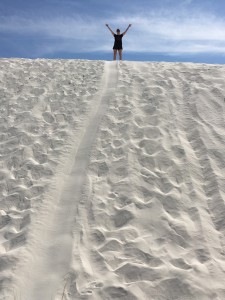
Oh, and my finish time was 5:19:02. I was 47th of 785 women in my “civilian light” division.
Grandpa, every step was for you. Thank you for the unwavering confidence, for encouraging me to look at the good side of life, and for setting an example of determination.
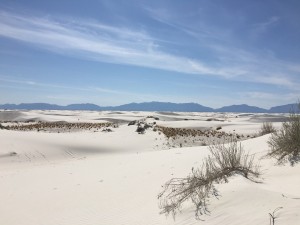
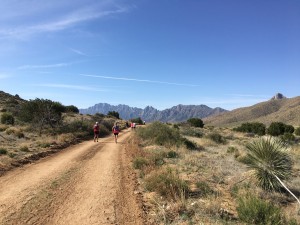
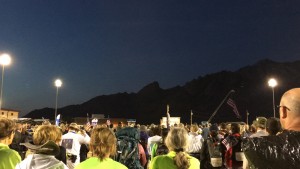
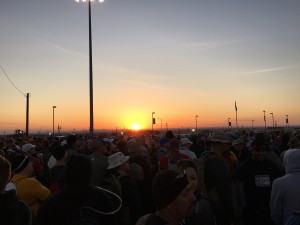
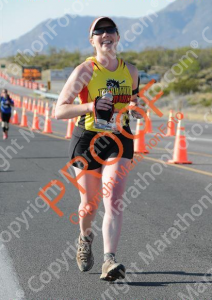
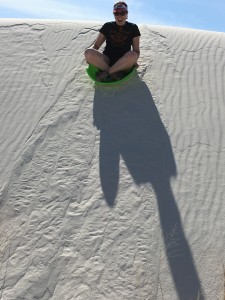
Well done. Super inspirational. Thanks for sharing.
<3
That was lovely. Congrats!